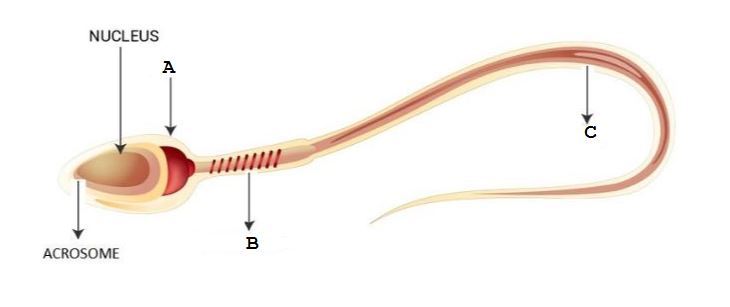12th Grade > Biology
GROWTH & REPRODUCTION IN PLANTS AND ANIMALS MCQs
Plant Growth And Development, Reproduction In Animals, Sexual Reproduction In Flowering Plants
Total Questions : 111
| Page 3 of 12 pages
Answer: Option D. -> Both A & C
:
D
Cytokinins are artificially synthesised from adenosine monophosphate (AMP) and isopentenyl pyrophosphate.
:
D
Cytokinins are artificially synthesised from adenosine monophosphate (AMP) and isopentenyl pyrophosphate.
Answer: Option D. -> Primary cell walls are deposited with chitin
:
D
To form tracheary elements from meristematic cell, the cells lose protoplasm and develop very strong elastic lignocellulosic secondary walls to carry water to long distances even under extreme tension. Primary cell walls are cellulosic in nature.
:
D
To form tracheary elements from meristematic cell, the cells lose protoplasm and develop very strong elastic lignocellulosic secondary walls to carry water to long distances even under extreme tension. Primary cell walls are cellulosic in nature.
:
Quantitative comparisons between living systems can be made in terms of growth rates. Measurement and comparison of total growth per unit time is called absolute growth rate; ABR=total growth/ time.
Answer: Option B. -> Fallopian tube
:
B
Fertilisation is the fusion of male and female gametes. In human beings, it takes place in the fallopian tube of the female reproductive system.
:
B
Fertilisation is the fusion of male and female gametes. In human beings, it takes place in the fallopian tube of the female reproductive system.
Answer: Option C. -> Smaller than the parent organism.
:
C
Some cells split through a process called budding. The mother cells produces one or more daughter cells or buds. The daughter cell is smaller than the parent organism. E.g.- yeast. These buds or daughter cells grow outside the parent organism.
:
C
Some cells split through a process called budding. The mother cells produces one or more daughter cells or buds. The daughter cell is smaller than the parent organism. E.g.- yeast. These buds or daughter cells grow outside the parent organism.
Answer: Option A. -> True
:
A
Animals can reproduce both by sexual as well as asexual means. Simple animals like Hydra, reproduce asexually by the process of budding. Some animals like tapeworms can reproduce both asexually as well as sexually. Higher and more complex animals like birds and mammals can reproduce only by sexual means.
:
A
Animals can reproduce both by sexual as well as asexual means. Simple animals like Hydra, reproduce asexually by the process of budding. Some animals like tapeworms can reproduce both asexually as well as sexually. Higher and more complex animals like birds and mammals can reproduce only by sexual means.
Answer: Option B. -> A - Head, B - Middle Piece, C - Tail
:
B
The part of a sperm cell which contains the male nucleus is called the 'head' (A). The middle portion (B) is known as the 'middle piece'. It contains mitochondria which provideenergy for sperm movement. The last portion (C) is known as the 'tail'and is responsible for sperm motility.
:
B
The part of a sperm cell which contains the male nucleus is called the 'head' (A). The middle portion (B) is known as the 'middle piece'. It contains mitochondria which provideenergy for sperm movement. The last portion (C) is known as the 'tail'and is responsible for sperm motility.
Answer: Option D. -> binary fission
:
D
Binary fission is a type of asexual reproduction seen in unicellular organisms. In this method, first the nucleus divides followed by cytoplasmic division. This forms two daughter cells from one parent cell. Therefore, Paramecium dividing itself to form two daughter cells represents binary fission.
:
D
Binary fission is a type of asexual reproduction seen in unicellular organisms. In this method, first the nucleus divides followed by cytoplasmic division. This forms two daughter cells from one parent cell. Therefore, Paramecium dividing itself to form two daughter cells represents binary fission.
Answer: Option A. -> True
:
A
Ininternal fertilisation, the survival chancesof the zygote are more than external fertilisation. In external fertilisation, the male and female gametes are released into the environment (mostly in water) and fertilisation takes place outside the body of both the parents. Thus, there is a higher chance of the gametes and the zygote getting destroyed by agents like water, wind, heat andpredators.
:
A
Ininternal fertilisation, the survival chancesof the zygote are more than external fertilisation. In external fertilisation, the male and female gametes are released into the environment (mostly in water) and fertilisation takes place outside the body of both the parents. Thus, there is a higher chance of the gametes and the zygote getting destroyed by agents like water, wind, heat andpredators.
Answer: Option D. -> One
:
D
In asexual reproduction, only one parent is involved.Asexual reproductionis a mode ofreproductionin which offspring arise from a single organismand inherit the genes of that parent only.
:
D
In asexual reproduction, only one parent is involved.Asexual reproductionis a mode ofreproductionin which offspring arise from a single organismand inherit the genes of that parent only.

















